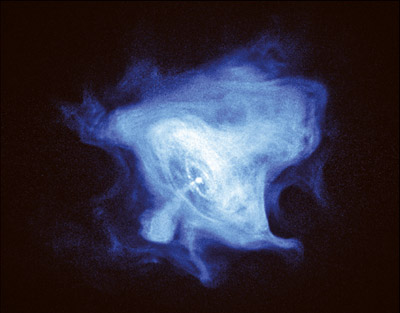
Image credit: NASA/CXC/SAO/F Seward et al.
The Crab nebula is the brightest persistent gamma-ray source in the sky with radiation detected up to very high energies (VHE), above 100 GeV. The surprising result of the Very Energetic Radiation Imaging Telescope Array System (VERITAS) is the detection of pulsed radiation from the Crab in this extreme energy range, a new challenge for theorists.
VERITAS is an array of four 12-m telescopes using the imaging air Cherenkov technique (IACT) to detect VHE gamma-rays. Located in Arizona, it is the American equivalent of two European Cherenkov telescope facilities: the Major Atmospheric Gamma-ray Imaging Cherenkov telescope (MAGIC) on the Canary Islands and the High Energy Stereoscopic System (HESS) (CERN Courier January/February 2005 p30 and June 2009 p20). The IACT uses the Earth’s atmosphere as a gamma-ray detector where VHE photons interact with atomic nuclei to produce electron–positron pairs, which create a cascade of charged particles. The latter can travel faster than light in the air, thus producing a flash of Cherenkov radiation in the optical-UV range that is recorded by the telescopes on the ground. The telescope’s camera is an array of photomultipliers that produce an image of the particle shower, which develops at an altitude of 10–20 km and retains the information on the direction and energy of the incoming gamma-ray photon.
The Crab nebula is the remnant of a supernova explosion witnessed by Chinese and Arab astronomers in 1054 AD and its pulsed emission at radio frequencies was discovered in 1969. The regular pulses revealed the presence of a strongly magnetized neutron star – the collapsed core of the defunct star only about 30 km across – rotating 30 times per second. The same periodic signal from the pulsar was subsequently detected in the optical, X-ray and gamma-ray domain. In 2008, MAGIC was the first Cherenkov telescope to detect pulsed radiation from the Crab above an energy of 25 GeV. It was, however, generally thought that the gamma-ray emission spectrum of the pulsar would cut off at higher energies preventing a detection with current instrumentation above 100 GeV.
As VERITAS has a higher energy- threshold than MAGIC, there was only a faint hope that a long observation of the Crab nebula could provide a meaningful detection. Nevertheless, with 107 hours of observations between September 2007 and March 2011 the challenge paid off and the VERITAS collaboration has reported a 6σ detection of the VHE pulsed emission from the Crab. The observed spectrum published in the Science covers the 100–400 GeV range at a flux of about 1% that of the nebula at 150 GeV. Combining the VERITAS data with the lower-energy measurements by MAGIC and the Fermi gamma-ray space telescope provides a broad spectrum extending from 100 MeV to 400 GeV. The new observations clearly disfavour a power-law model with an exponential cut-off. Instead they suggest that the pulsed gamma-ray emission from the Crab is a broken power-law with a break at a photon energy of about 4 GeV.
The unexpected VHE observations are extremely difficult to reconcile with emission from the magnetic poles of the neutron star. Indeed, the authors of the paper find that the highest energy gamma-rays they measure can only be emitted at a distance of more than 10 stellar radii from the neutron star’s surface. They also find that curvature radiation – the emission of electrons following curved magnetic field lines – is unlikely to produce gamma rays above 100 GeV. A plausible alternative could be inverse-Compton scattering, but the theory is not yet able to define clearly where such a process could take place. The fact that the pulses observed by VERITAS are narrower by a factor two to three compared with those observed by Fermi at 100 MeV and that the secondary pulse becomes the dominant one in the VERITAS energy range could be interesting clues for theorists.








